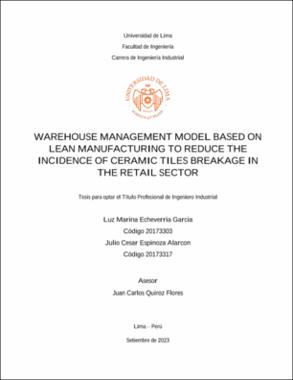Mostrar el registro sencillo del ítem
Warehouse management model based on lean manufacturing to reduce the incidence of ceramic tiles breakage in the retail sector
| dc.contributor.advisor | Quiroz Flores, Juan Carlos | |
| dc.contributor.author | Echeverria Garcia, Luz Marina Natalia | |
| dc.contributor.author | Espinoza Alarcon, Julio Cesar | |
| dc.date.accessioned | 2023-11-15T16:30:22Z | |
| dc.date.available | 2023-11-15T16:30:22Z | |
| dc.date.issued | 2023 | |
| dc.identifier.citation | Echeverria Garcia, L. M. N. & Espinoza Alarcon, J. C. (2023). Warehouse management model based on lean manufacturing to reduce the incidence of ceramic tiles breakage in the retail sector [Tesis para optar el Título Profesional de Ingeniero Industrial, Universidad de Lima]. Repositorio institucional de la Universidad de Lima. https://hdl.handle.net/20.500.12724/19292 | es_PE |
| dc.identifier.uri | https://hdl.handle.net/20.500.12724/19292 | |
| dc.description.abstract | This research analyzed the problem of broken products that negatively affect retail construction finishing companies. For this reason, the study was conducted in a retail company in the mentioned sector. The main problem is broken ceramic tiles found throughout the logistics process. This company has a rate of product breakage of 2.15%, equivalent to 707,704.58 PEN in total cost and costs involved. The leading causes of this problem are poor storage and transportation of products 26.32% and inadequate control and handling of products 27. 03% and poor handling with the forklift 25.97%. A model was formulated under the Lean Manufacturing and warehouse management methodology divided into three stages for the implementation of the tools: "Order and Stability," which consists of the performance of the 5S combined with warehouse management tools, and "Planned Flow," which focuses on the implementation of SLP, and the last phase is called "Make Kaizen Flow" which focuses on the combination of standard work and the Kaizen Philosophy. Finally, through a simulation, it is determined that the application of this model reduces the main problem to 1.65% and allows standardizing activities and improving the order and distribution of the warehouse. This research will be an example for future implementations for companies in the retail sector of construction finishes. | es_PE |
| dc.format | application/pdf | es_PE |
| dc.language.iso | spa | es_PE |
| dc.publisher | Universidad de Lima | es_PE |
| dc.rights | info:eu-repo/semantics/openAccess | * |
| dc.rights.uri | https://creativecommons.org/licenses/by-nc-sa/4.0/ | * |
| dc.source | Repositorio Institucional - Ulima | es_PE |
| dc.source | Universidad de Lima | es_PE |
| dc.subject | Gestión de almacenes | es_PE |
| dc.subject | Producción eficiente | es_PE |
| dc.subject | Baldosas | es_PE |
| dc.subject | Warehouses management | es_PE |
| dc.subject | Lean manufacturing | es_PE |
| dc.subject | Tiles | es_PE |
| dc.subject.classification | Ingeniería industrial / Producción y logística | es_PE |
| dc.title | Warehouse management model based on lean manufacturing to reduce the incidence of ceramic tiles breakage in the retail sector | es_PE |
| thesis.degree.discipline | Ingeniería Industrial | es_PE |
| thesis.degree.grantor | Universidad de Lima. Facultad de Ingeniería y Arquitectura | es_PE |
| thesis.degree.level | Título Profesional | es_PE |
| thesis.degree.name | Ingeniero Industrial | es_PE |
| dc.publisher.country | PE | es_PE |
| dc.subject.ocde | https://purl.org/pe-repo/ocde/ford#2.11.04 | |
| renati.author.dni | 72446039 | |
| renati.author.dni | 71850057 | |
| renati.advisor.orcid | https://orcid.org/0000-0003-1858-4123 | |
| renati.advisor.dni | 10300285 | |
| renati.juror | Santos Figueroa, Luis Enrique | |
| renati.juror | Quiroz Flores, Juan Carlos | |
| renati.juror | Collao Díaz, Martín Fidel | |
| renati.level | http://purl.org/pe-repo/renati/level#tituloProfesional | * |
| renati.type | https://purl.org/pe-repo/renati/type#tesis | * |
| renati.discipline | 722026 | |
| ulima.cat | 9 |
Ficheros en el ítem
Este ítem aparece en la(s) siguiente(s) colección(ones)
-
Tesis [800]





